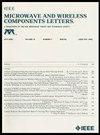HIE-FDTD方法的当前源实现
IF 3.3
2区 工程技术
Q2 ENGINEERING, ELECTRICAL & ELECTRONIC
引用次数: 0
摘要
在这封信中,介绍了混合隐显时域有限差分(HIE-FDTD)、改进的HIE-FDDD和跳跃式HIE-FDDT方法的当前源代码实现。对于时间索引参数的所有可能值,研究了这些HIE-FDTD方法的不对称性和场误差。所提出的实现为所有三种HIE–FDTD方法提供了非常低的不对称性和场误差。这些HIE-FDTD方法给出的场误差低于交替方向隐式时域有限差分(ADI-FDTD)方法给出的误差。本文章由计算机程序翻译,如有差异,请以英文原文为准。
Current Source Implementations for the HIE-FDTD Methods
In this letter, the current source implementations are presented for the hybrid implicit–explicit finite-difference time-domain (HIE-FDTD), the improved HIE-FDTD, and the leapfrog HIE-FDTD methods. The asymmetry and the field errors of these HIE-FDTD methods are investigated for all possible values of the time index parameters. The proposed implementations give very low asymmetry and field errors for all the three HIE–FDTD methods. The field errors given by these HIE-FDTD methods are lower than those given by the alternating direction implicit finite-difference time-domain (ADI-FDTD) method.
求助全文
通过发布文献求助,成功后即可免费获取论文全文。
去求助
来源期刊

IEEE Microwave and Wireless Components Letters
工程技术-工程:电子与电气
自引率
13.30%
发文量
376
审稿时长
3.0 months
期刊介绍:
The IEEE Microwave and Wireless Components Letters (MWCL) publishes four-page papers (3 pages of text + up to 1 page of references) that focus on microwave theory, techniques and applications as they relate to components, devices, circuits, biological effects, and systems involving the generation, modulation, demodulation, control, transmission, and detection of microwave signals. This includes scientific, technical, medical and industrial activities. Microwave theory and techniques relates to electromagnetic waves in the frequency range of a few MHz and a THz; other spectral regions and wave types are included within the scope of the MWCL whenever basic microwave theory and techniques can yield useful results. Generally, this occurs in the theory of wave propagation in structures with dimensions comparable to a wavelength, and in the related techniques for analysis and design.
 求助内容:
求助内容: 应助结果提醒方式:
应助结果提醒方式:


